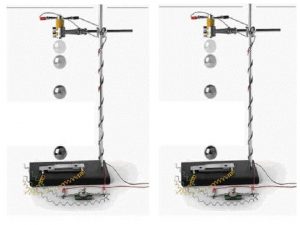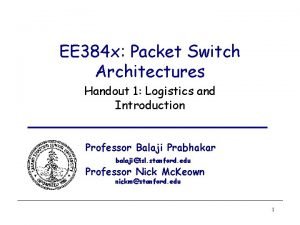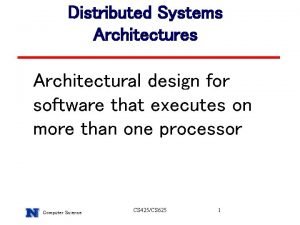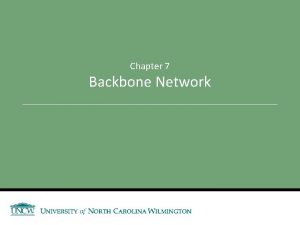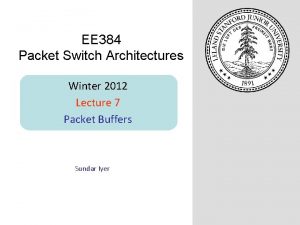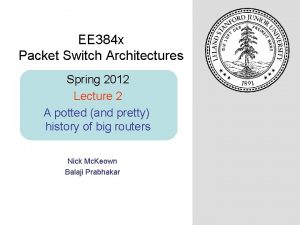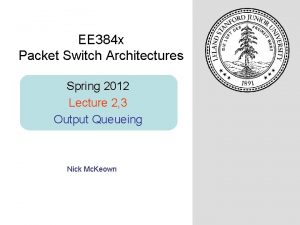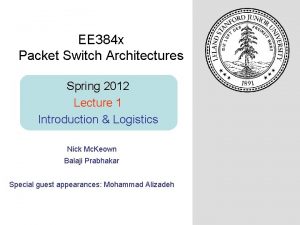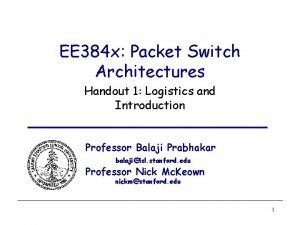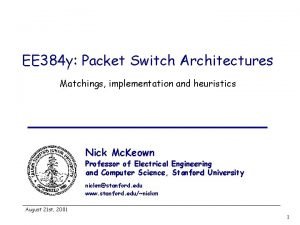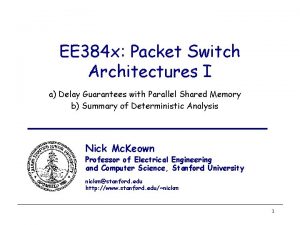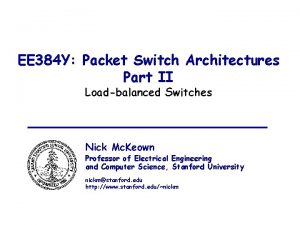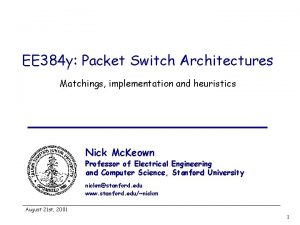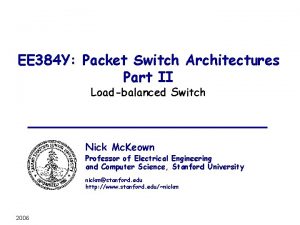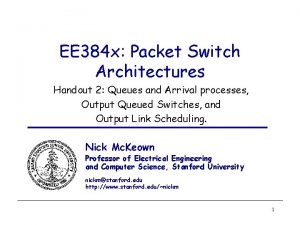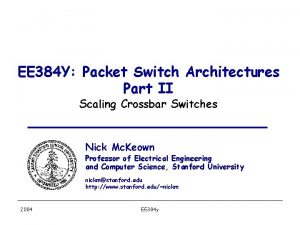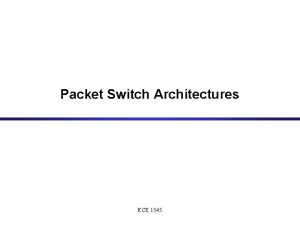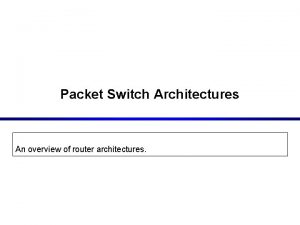EE 384 Packet Switch Architectures Winter 2012 Lecture






































- Slides: 38

EE 384 Packet Switch Architectures Winter 2012 Lecture 8 a Packet Buffers with Latency Sundar Iyer

Reducing the size of the SRAM Intuition • If we use a lookahead buffer to peek at the requests “in advance”, we can replenish the SRAM cache only when needed. • This increases the latency from when a request is made until the byte is available. • But because it is a pipeline, the issue rate is the same.

Algorithm Queues Q 1. Lookahead: Next Q(b – 1) + 1 arbiter requests are known. Requests in Lookahead Buffer b-1 Q(b-1) + 1 2. Compute: Determine which queue will run into “trouble” soonest. green! Queues 3. Replenish: Fetch b bytes for the “troubled” queue. Q b-1

Example Q=4, b=4 Queues Requests in lookahead buffer t = 0; Green Critical Requests in lookahead buffer t=3 Requests in lookahead buffer t=6 Queues Requests in lookahead buffer t=1 t=2 Requests in lookahead buffer t=5 t = 4; Blue Critical Requests in lookahead buffer t=7 EE 384 x Requests in lookahead buffer 4 t = Winter 8; Red Critical 2008

Claim Patient Arbiter: With an SRAM of size Q(b – 1), a requested byte is available no later than Q(b – 1) + 1 after it is requested. Example: 160 Gb/s linecard, b=2560, Q=512: SRAM = 1. 3 MBytes, delay bound is 65 ms (equivalent to 13 miles of fiber).

Controlling the latency What if application can only tolerate a latency l < Q(b – 1) + 1 timeslots? Algorithm: Serve a queue once every b timeslots in the following order: 1. If there is an earliest critical queue, replenish it. 2. If not, then replenish the queue that will have the largest deficit timeslots in the future. l

Queue length vs. Pipeline depth Q=1000, b = 10 SRAM Size Queue Length for Zero Latency Queue Length for Maximum Latency Pipeline Latency, x

Some Real Implementations • Cache size can be further optimized based on ¾ ¾ ¾ Using embedded DRAM Dividing queues across ingress, egress Grouping queues into aggregates (10 X 1 G is a 10 G stream) Knowledge of the scheduler pattern Granularity of the read scheduler • Most Implementations – – Q < 1024 (original buffer cache), Q < 16 K (modified schemes) 15+ unique designs 40 G to 480 G streams Cache Sizes < 32 Mb (~ 8 mm 2 in 28 nm implementation)

EE 384 Packet Switch Architectures Winter 2012 Lecture 8 b Statistics Counters Sundar Iyer

What is a Statistics Counter? • When a packet arrives, it is first classified to determine the type of the packet. • Depending on the type(s), one or more counters corresponding to the criteria are updated/incremented

Examples of Statistics Counters • Packet switches maintain counters for – Route prefixes, ACLs, TCP connections – SNMP MIBs • Counters are required for – Traffic Engineering • Policing & Shaping – Intrusion detection – Performance Monitoring (RMON) – Network Tracing

Motivation: Build high speed counters Determine and analyze techniques for building very high speed (>100 Gb/s) statistics counters and support an extremely large number of counters. OC 192 c = 10 Gb/s; Counters/pkt (C) = 10; Reff = 100 Gb/s; Total Counters (N) = 1 million; Counter Size (M) = 64 bits; Counter Memory = N*M = 64 Mb; MOPS =150 M reads, 150 M writes Stanford University

Question • Can we use the same packet-buffer hierarchy to build statistics counters? • Ans: Yes – Modify MDQF Algorithm – Numbers of Counters = N – Consider counters in base 1 • Mimics cells of size 1 bit per second – Create Longest Counter First Algorithm – Maximum size of counter (base 1): ~ b(2 + ln N) – Maximum size of counter (base 2): ~ log 2 b (2 + ln N)

Optimality of LCF-CMA Can we do better? Theorem: LCF-CMA, is optimal in the sense that it minimizes the size of the counter maintained in SRAM Stanford University 14

Minimum Size of the SRAM Counter Theorem: (speed-down factor b>1) LCF-CMA, minimizes the size of counter (in bits) in the SRAM to: f(b, N) = log 2 = Stanford University ( ) ln b. N ____ ln [b/(b-1)] (log N) 15

Implementation Numbers Example: • • • OC 192 Line Card : R = 10 Gb/sec. No. of counters per packet : C = 10 Reff= R*C : 100 Gb/s Cell Size : 64 bytes Teff = 5. 12/2 : 2. 56 ns DRAM Random Access Time : 51. 2 ns Speed-down Factor, b >= T/Teff : 20 Total Number of Counters : 1000, 1 million Size of Counters : 64 bits, 8 bits

Implementation Examples 10 Gb/s Line Card Values f(b, N) Brute Force LCF-CMA N=1000 M=8 8 SRAM=8 Kb DRAM=0 SRAM=8 Kb DRAM=8 Kb N=1000 M=64 8 SRAM=64 Kb DRAM=0 SRAM=8 Kb DRAM=64 Kb N=1000000 M=64 9 SRAM=64 Mb DRAM=0 SRAM=9 Mb DRAM=64 Mb

Conclusion • The SRAM size required by LCF-CMA is a very slow growing function of N • There is a minimal tradeoff in SRAM memory size • The LCF-CMA technique allows a designer to arbitrarily scale the speed of a statistics counter architecture using existing memory technology

EE 384 Packet Switch Architectures Winter 2012 Lecture 8 c Qo. S and PIFO Sundar Iyer

Contents 1. Parallel routers: work-conserving (Recap) 2. Parallel routers: delay guarantees 20

The Parallel Shared Memory Router At most one operation – a write or a read per time slot Memory A 5 Memory 1 A 4 Memory A 4 A 3 R A Memory A 1 A 5 C 3 Memory B 1 C 3 R C Memory B 3 Arriving Packets Memory B 1 Memory K=8 C 1 21 B A 1 Departing Packets C 1

Problem • Problem : – How can we design a parallel output-queued workconserving router from slower parallel memories? v Theorem 1: (sufficiency) Ø 22 A parallel output-queued router is work-conserving with 3 N – 1 memories that can perform at most one memory operation per time slot

Re-stating the Problem • There are K cages which can contain an infinite number of pigeons. • Assume that time is slotted, and in any one time slot – at most N pigeons can arrive and at most N can depart. – at most 1 pigeon can enter or leave a cage via a pigeon hole. – the time slot at which arriving pigeons will depart is known • For any router: 23

Intuition for Theorem 1 Time = t DT=t+X • Only one packet can enter a memory at time t v Memory DT=t+X 24 v Only one packet can enter or leave a memory at time t Only one packet can enter or leave a memory at any time

Proof of Theorem 1 • When a packet arrives in a time slot it must choose a memory not chosen by 1. The N – 1 other packets that arrive at that timeslot. 2. The N other packets that depart at that timeslot. 3. The N - 1 other packets that can depart at the same time as this packet departs (in future). • 25 Proof:

The Parallel Shared Memory Router At most one operation – a write or a read per time slot Memory A 5 Memory 1 A 4 Memory A 4 A 3 R A Memory A 1 A 5 C 3 B Memory A 1 B 1 C 3 R C Memory B 3 Arriving Packets Memory B 1 C 1 Departing Packets Memory K=8 C 1 26 From theorem 1, k = 7 memories don’t suffice. . but 8 memories do

Summary - N Mem. BW per Mem 1 (N+1)R Total Mem. BW N(N+1)R Switch BW NR Switch Algorithm None Bus 1 2 NR 2 NR None Crossbar N 2 R 2 NR NR MWM 2 N 3 R 6 NR 2 NR Maximal 2 N 3 R 6 NR 3 NR Time Reserve* k 3 NR/k 3 NR 2 NR C. Sets N 3 R 3 NR 4 NR Edge Color N 3 R 3 NR 6 NR C. Sets N 4 R 4 NR C. Sets Nk 2 R(N+1)/k 2 N(N+1)R 4 NR C. Sets Nk 4 NR/k 4 NR C. Sets Nk 2 NR/k 2 NR None Fabric # Mem. Output-Queued Bus C. Shared Mem. Input Queued CIOQ (Cisco) Crossbar P Shared Mem. Bus DSM (Juniper) Xbar PPS - OQ Clos PPS –Shared Memory 1 Routers which give 100% throughput Clos Note that lower mem. bandwidth per memory implies higher random access time, which is better 27

Contents 1. Parallel routers: work-conserving 2. Parallel routers: delay guarantees 28

Delay Guarantees one output, many logical FIFO queues 1 Weighted fair queueing sorts packets constrained traffic m one output, single PIFO queue PIFO models push Ø constrained traffic Ø Push In First Out (PIFO) 29 Ø Weighted Fair Queueing Weighted Round Robin Strict priority etc.

Delay Guarantees • v Problem : – How can we design a parallel output-queued router from slower parallel memories and give Thisdelay is difficult because guarantees? Ø Ø 30 The counting technique depends on being able to predict the departure time and schedule it. The departure time of a cell is not fixed in policies such as strict priority, weighted fair queueing etc.

Theorem 2 v Theorem 2: (sufficiency) Ø 31 A parallel output-queued router can give delay guarantees with 4 N – 2 memories that can perform at most one memory operation per time slot.

Intuition for Theorem 2 N=3 port router DT = 3 … … 9 8 7 8 DT= 2 7 6 5 6 5 4 5 DT= 1 4 3 2 1 Departure Order FIFO: Window of memories of size N-1 that can’t be used 2. 5 PIFO: 2 windows of memories of size N-1 that can’t be used Departure 2. 5 3 2 1 Order N-1 packets before cell at time of insertion 1. 5 … 8 7 7 6 6 5 5 4 4 3 3 2. 5 N-1 packets after cell at time of insertion 32 2. 5 2 2 1. 5 1 Departure Order

Proof of Theorem 2 Time = t DT=t Before C After C DT=t+T Cell C 33 A packet cannot use the memories: 1. Used to write the N-1 arriving cells at t. 2. Used to read the N departing cells at t. 3. Will be used to read the N-1 cells that depart before it. 4. Will be used to read the N-1 cells that depart after it.

Summary- Routers which give delay guarantees Total Memory BW N(N+1)R Switch BW NR Switch Algorithm N Mem. BW per Mem. (N+1)R Bus 1 2 NR 2 NR None Crossbar N 2 R 2 NR NR - 2 N 3 R 6 NR 2 NR Marriage 2 N 3 R 6 NR 3 NR Time Reserve k 4 NR/k 4 NR 2 NR C. Sets N 4 R 4 NR 5 NR Edge Color N 4 R 4 NR 8 NR C. Sets N 6 R 6 NR C. Sets Nk 3 R(N+1)/k 3 N(N+1)R 6 NR C. Sets Nk 6 NR/k 6 NR C. Sets Nk 2 NR/k 2 NR - Fabric # Mem. Output-Queued Bus C. Shared Mem. Input Queued CIOQ (Cisco) Crossbar P. Shared M Bus DSM (Juniper) Xbar PPS - OQ Clos PPS –Shared Memory 34 Clos None

Backups 35

Distributed Shared Memory Router Switch Fabric Memories R Line Card 1 • • • 36 Memories R Line Card 2 Memories R Line Card N The central memories are moved to distributed line cards and shared Memory and line cards can be added incrementally From theorem 1, 3 N – 1 memories which can perform one operation per time slot i. e. a total memory bandwidth of 3 NR suffice for the router to be work-conserving

Corollary 1 • Problem: – What is the switch bandwidth for a workconserving DSM router? • Corollary 1: (sufficiency) – A switch bandwidth of 4 NR is sufficient for a distributed shared memory router to be workconserving • Proof 1: 37

Corollary 2 • Problem: – What is the switching algorithm for a work-conserving DSM router? • Bus • Crossbar : No algorithm needed, but impractical : Algorithm needed because only permutations are allowed • Corollary 2: (existence) – An edge coloring algorithm can switch packets for a work-conserving distributed shared memory router • Proof : – Follows from König’s theorem - Any bipartite graph with maximum degree has an edge coloring with colors 38
 Switch boot sequence
Switch boot sequence Winter kommt winter kommt flocken fallen nieder lied
Winter kommt winter kommt flocken fallen nieder lied Es ist kalt es ist kalt flocken fallen nieder
Es ist kalt es ist kalt flocken fallen nieder Winter kommt winter kommt flocken fallen nieder
Winter kommt winter kommt flocken fallen nieder Clos criteria formula
Clos criteria formula Go switch limit switch
Go switch limit switch Switch mode power supply lecture notes
Switch mode power supply lecture notes 01:640:244 lecture notes - lecture 15: plat, idah, farad
01:640:244 lecture notes - lecture 15: plat, idah, farad 384 bc
384 bc Instagira
Instagira Aristotle born in
Aristotle born in Iec 384-14
Iec 384-14 384 bce
384 bce 384 bc means
384 bc means 384 bce
384 bce Aristote 384-322
Aristote 384-322 384 bc
384 bc Maximum weight matching
Maximum weight matching Długość pewnej linii kolejowej to około 318 km
Długość pewnej linii kolejowej to około 318 km 384 bc
384 bc Ee
Ee Nació en macedonia en el 384 a. c.
Nació en macedonia en el 384 a. c. 384-322
384-322 Practice 11-1 simplifying radicals answers
Practice 11-1 simplifying radicals answers Banking system architecture diagram
Banking system architecture diagram Gui architectures
Gui architectures Autoencoders, unsupervised learning, and deep architectures
Autoencoders, unsupervised learning, and deep architectures 3 tier architecture of data warehouse
3 tier architecture of data warehouse Database storage architecture
Database storage architecture Backbone network architectures
Backbone network architectures Theo schlossnagle
Theo schlossnagle Database system architectures
Database system architectures Classification of instruction set architecture
Classification of instruction set architecture Base system architectures
Base system architectures Cache coherence for gpu architectures
Cache coherence for gpu architectures Cdn architectures
Cdn architectures Architecture e commerce
Architecture e commerce Fundamental and incidental interactions
Fundamental and incidental interactions Backbone network architectures
Backbone network architectures















